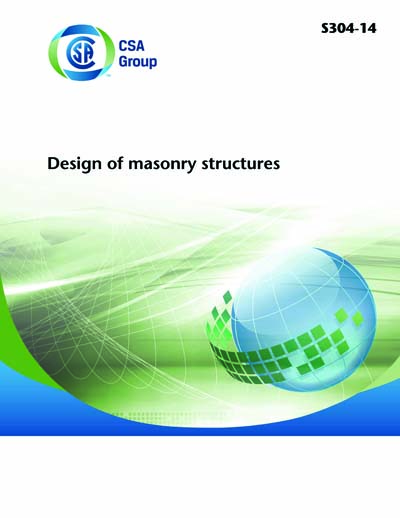Historical
CSA S304-2014
S304-14 - Design of masonry structures
Preface
This is the third edition of CSA S304, Design of masonry structures, using limit states design principles. It supersedes the previous editions published in 2004, under the designation CSA S304.1, and 1994, under the designation CSA S304.1 and the title Masonry Design for Buildings (Limit States Design). Prior to the limit states design edition in 1994, there were two working stress design editions, CSA S304-M84 and the first edition of CSA S304 issued in 1977 (imperial version) and 1978 (metric version). Major changes have been made in this edition. The largest changes involve new and revised seismic provisions, including the creation of a separate clause (Clause 16) dedicated to this subject. Clause 16 includes requirements for new and increased seismic ductility-related force-modification factors and the related design limitations. Other new content includes clauses on anchor bolt design and arch design. The empirical design requirements contained in Annex F have been revised and significant changes to design of dimension cut stone and manufactured stone veneer have been introduced into Annex A. Other major changes include (a) revised reinforcement provisions for shear walls, including minimum spacing for horizontal reinforcement and continuity requirements for vertical reinforcement; (b) new strut stiffness provisions for analysis of buildings containing infill shear walls; (c) revised shear capacity of beams, including the introduction of both a general and a simplified method of calculating shear capacity of beams based on compression field theory; (d) revised requirements for reinforcing at intersections between walls; (e) revised requirements for intermediate longitudinal reinforcement in beams; and (f) revised limit on maximum bar size allowed from 30M down to 25M. Users of this Standard are advised that many other clauses contain minor technical and editorial changes to correct or clarify previous requirements. The masonry industry in Canada has provided funding for the development of this Standard through the CMCA Annual Conference sponsorship.Scope
1.1 General This Standard specifies requirements for the structural design of unreinforced, reinforced, and prefabricated masonry structures and components in accordance with the limit states design method of the National Building Code of Canada. This Standard also provides requirements for the structural design of prestressed masonry beams, walls, and columns in accordance with the limit states design method of the National Building Code of Canada. In addition, this Standard provides requirements for the empirical design of unreinforced masonry in Annex F. Note: This Standard assumes that review of the structural work designed under this Standard and review of the inspection and test results required by this Standard will be carried out during construction by the designer or another suitably qualified person to determine general conformance with the design. 1.2 Other masonry standards Requirements for mortar and grout for unit masonry, masonry connectors, and masonry construction are specified in CSA A179, CSA A370, and CSA A371, respectively. These Standards include requirements that affect the design and are required for use with this Standard. 1.3 Vehicular bridges This Standard does not apply to the structural design of vehicular bridges. 1.4 Partitions This Standard applies to the structural design of partitions subject to unusual loads such as wind loads, significant internal air pressure differences, or large eccentric loads mounted to the wall. Where it can be shown that the masonry partitions are not subjected to these unusual loads, the masonry partitions may be designed using Annex F. 1.5 Thin veneers secured by mortar adhesion This Standard does not apply to the structural design of thin veneers individually secured by mortar adhesion to a structural support or to the structural design of rough stone veneer. See CSA A371 for prescriptive requirements and limitations. 1.6 Rough stone masonry This Standard does not apply to the structural design of rough (rubble) stone masonry, except as covered in Annex F. See CSA A371 for prescriptive requirements. 1.7 Terminology In this Standard, shall is used to express a requirement, i.e., a provision that the user is obliged to satisfy in order to comply with the standard; should is used to express a recommendation or that which is advised but not required; may is used to express an option or that which is permissible within the limits of the standard. Notes accompanying clauses do not include requirements or alternative requirements; the purpose of a note accompanying a clause is to separate from the text explanatory or informative material. Notes to tables and figures are considered part of the table or figure and may be written as requirements. Annexes are designated normative (mandatory) or informative (non-mandatory) to define their application.Content Provider
CSA America, Inc. [csa]






